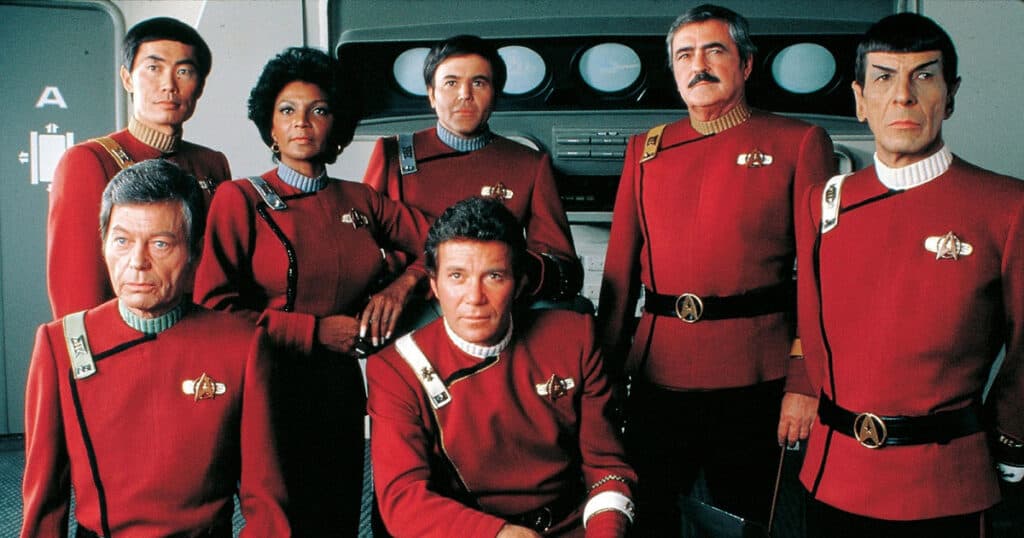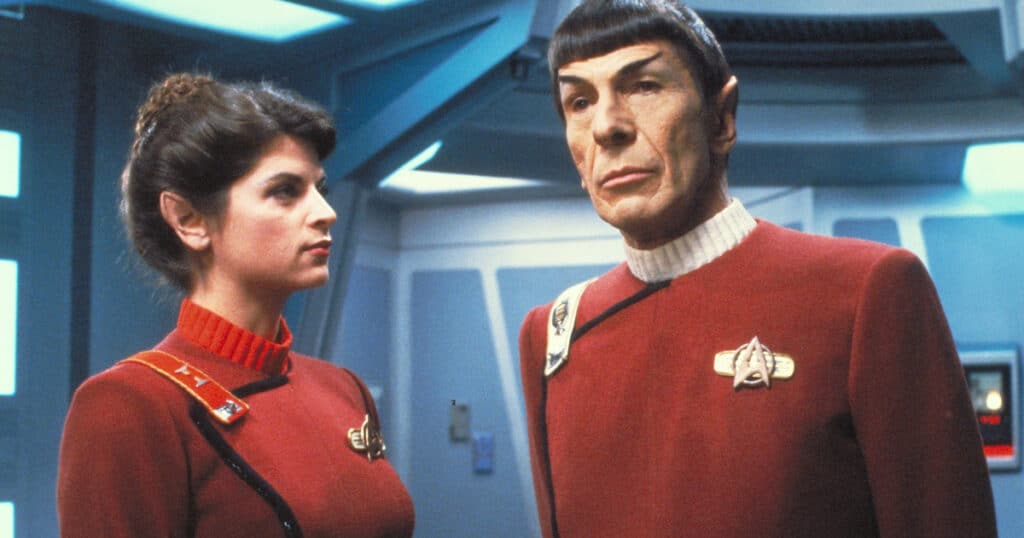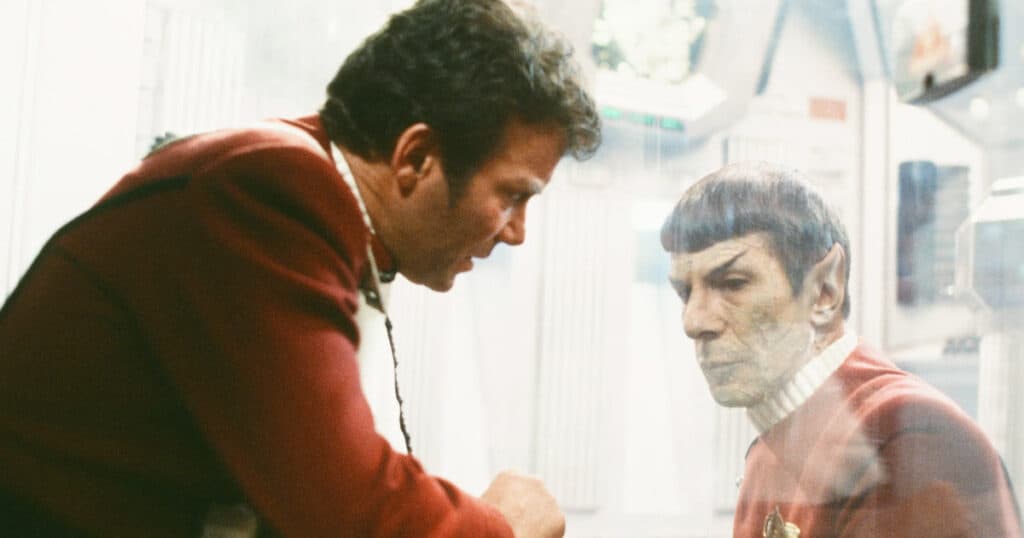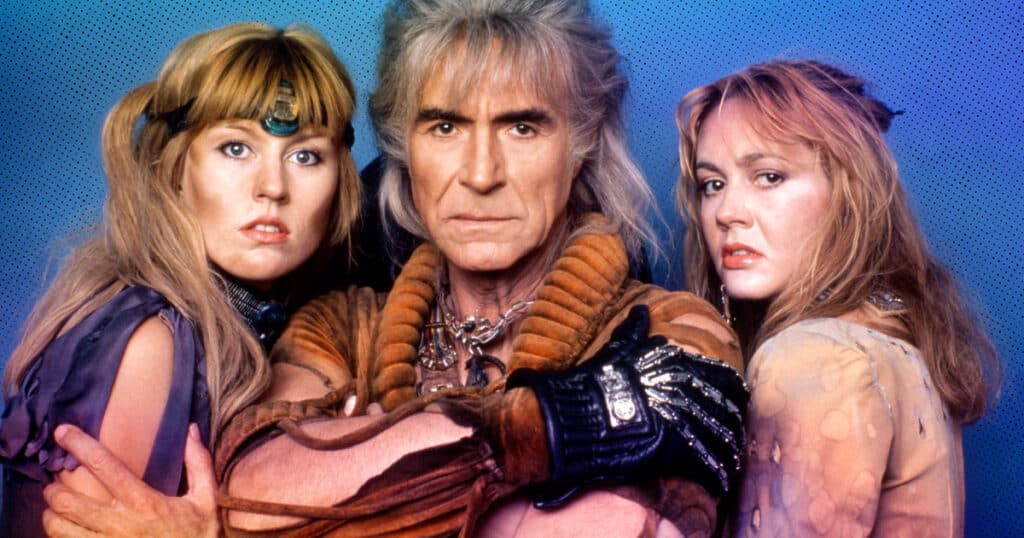In 1979, Paramount’s Star Trek: The Motion Picture hit theaters to a somewhat mixed reception from critics and audiences. Many had predicted that the film would be a big money loser because it had gone dramatically over-budget, making it one of the most expensive films ever made up to the point. In the end, the film eked out a profit. It did well enough that Paramount was willing to take another chance on the franchise. Still, their approach would be pretty different, drastically slashing the budget and hiring fewer A-listers behind the camera. But, to the surprise of all, this proved to be precisely the right move, with the resulting film, Star Trek II: The Wrath of Khana smash-hit that relaunched the franchise as a legitimate big-screen property and introduced the adventures of Kirk, Spock and McCoy to a whole new generation.
When Paramount Pictures was preparing for a sequel, the first thing they did was remove Gene Roddenberry, who had created the show, from the process. They wanted to take the franchise in a different direction, with TV veteran Harve Bennett being brought on to produce. The biggest priority for Paramount was to reduce the budget, and indeed Bennett was hired because he told them he could have made five movies for what the first film cost. While Star Trek: The Motion Picture cost $44 million, The Wrath of Khan would only cost $12 million. This is pretty impressive when you look at the movie and consider that it features some pretty epic space battles and contains early use of CGI. Indeed, the smartest thing they did was do to ILM, as George Lucas’ company had proven expertise in delivering cutting-edge effects for a budget, as it was the special effects, all done in-house, that pushed The Motion Picture‘s budget into the stratosphere.

Unlike the last movie, The Wrath of Khan focuses on the original crew, with no additional juvenile leads, such as the first movie’s Will and Ilya. Instead, we get the late Kirstie Alley as Saavik, a half Romulan/ half Vulcan officer who’s steals some scenes. The movie would flesh out the Kirk character, forcing him to reckon with his actions in the form of Ricardo Montalban’s Khan Noonian Singh. He was one of the best villains on the series, starring in an episode called Space Seed. In it, Khan was a genetically modified superman who, with his crew of superior humans, tried to hijack the Enterprise with the help of a crew member who fell in love with Khan. At the episode’s end, Kirk, empathizing to some degree with Khan, maroons him and his crew on a new planet, which the grateful superman takes as a challenge to conquer his own world. He’s even allowed to bring the crew woman who betrayed the Enterprise along as his wife. Here, in a surprisingly unseemly twist, we learn that Kirk never bothered to check on Khan and his crew and that, indeed, a disaster led to their world transforming into a hellish existence. Khan’s crew, including his wife, died agonizing deaths due to a parasitic worm that he eventually was able to master into a way to make people do his bidding, as Chekov and his Captain, Terrell, discover to their dismay.
The script was by TV veteran Jack B. Sowards and Harve Bennett himself. Still, the director they eventually chose to make the film, Nicholas Mayer, would overhaul the script without requesting pay or credit by simply noting the things people liked from the many previous drafts and combining them into one unified screenplay. It would pay off for Meyer, who became a popular script doctor at Paramount in the following years. Amazingly, Meyer had never seen a single episode of the show when he was chosen. Still, he had written a book and movie called The Seven Percent Solution, which reinvented Sherlock Holmes. He had made also made an excellent sci-fi gem called Time After Timewhich featured Malcolm McDowell as a time traveling HG Wells who had to stop Jack the Ripper, who’s run amuck in modern-day America.

While he may not have been a trekking expert, Meyer was a superb writer and director, and his idea for the film was to essentially make Horatio Hornblower in space. This is why the movie zeroes in on Kirk as a character in ways no other trekking film would tackle. Having reached middle age, Kirk considers himself over the hill and is consumed with regret. He knows he turned Khan into a monster, and his first battle with Khan leaves the Enterprise in ruins, with many of the young cadets staffing the ship, dying horrible deaths. Indeed, this mission would cost him dearly, with the most shocking part of the movie coming at the conclusion when his best friend Spock, once again played by Leonard Nimoy, sacrifices himself to save the Enterprise. Kirk would also come face to face with the son he abandoned, David (played by the late Merritt Butrick), whose mother, Carol Marcus (Bibi Besch), was a former lover of Kirk’s. Again – Kirk is very human in this; even having a family that he gave up in favor of his duty as Captain of the Enterprise.
While many mock William Shatner’s occasional lapses into overacting, he gives an outstanding performance as Kirk. In The Motion Picture, he was still trying to hold onto his youth, but here he’s paunchier, less of a ladies’ man, and basically, well – middle-aged. His flaws make him a greater hero than ever before, and Shatner plays it to the hilt.

As for Leonard Nimoy, here’s where it gets interesting. Many involved figured The Wrath of Khan would be the last star trek movie. Nimoy, who had moved on in his career, was enticed back with the one thing no actor can ever turn down – a great death scene. Yet, a few weeks into making the movie, all involved realized they had a winner on their hands, to the point that Paramount significantly increased the budget from a proposed $8.5 million to $12 million. Even Nimoy was having fun as Spock, especially given how good the material was, so he asked them to invent a device where, perhaps, his death wasn’t as final as assumed. This is why the insert of him doing a mind-meld with McCoy was included.
Overall, Meyer made a great movie, with Ricardo Montalban delivering the performance of his life as Khan. At the time Star Trek II was made, he was probably the biggest star in the cast, headlining the then-popular Fantasy Island series. Despite being in his sixties, Montalban had gotten chiselled for the role, with many assuming he was wearing a chest piece. He was always very muscular and trained so hard that Meyer had the costumes changed to emphasize his new physique. So no, the chest was all Montalban.

All of the elements came together spectacularly well in this, with composer James Horner breaking into the big leagues after delivering a sci-fi score that ranks as one of the classics of the eighties. Meyer also got a lot of attitude from the MPAA with this, as at the time, there was no PG-13, and PG movies, in general, could skirt with things that would nab them an R-now. Raiders of the Lost Ark is an excellent example of this, and so is Star Trek II, with some heavy-duty gore and violence, especially when Chekov and Tyrell get those worm creatures placed in their ears. One of the movie’s only issues is that Khan recognizes Chekov, although he wasn’t part of the crew when Space Seed was made. In the novelization, they explain that he was stationed in another part of the ship. The late Paul Winfield also delivers a sympathetic performance as the tortured Tyrell, who has a heck of a death scene of his own with him agonizingly turning a phaser on himself rather than kill Kirk, prompting Kirk’s immortal KHANNNNNN!!!!
In the end, Star Trek II: The Wrath of Khan would make less money than The Motion Picture, but given the movie’s budget, the profits for Paramount were out of this world. It made a whopping $78 million in North America, but, like many of the trekking movies to follow, it was a smaller hit internationally, with the US being the one place a trekking movie can always be relied on to make money (a lack of international success is what put the newer movies on ice). The studio made even more money when, in a savvy move, they made the then novel choice to release the film as a sell-through tape for $39.99, which seems steep now but was considered a bargain in 1983, as wow you could OWN a copy of Star Trek II on VHS, which was unheard of at the time. It became, at the time, the highest-selling videotape ever. On TV, it would be shown in an extended edition which, unlike The Motion Picture, would come to be known as the definitive version of the movie, with the most noteworthy addition being that a young crewman, Peter Preston, is Scotty’s nephew. This makes his agonizing death all the more moving, and explains why Scotty is so heartbroken. The film was such a smash that they immediately put a sequel into development. Indeed, a certain beloved crewmember with pointy ears would make a triumphant return, but that’s a story for another day…

